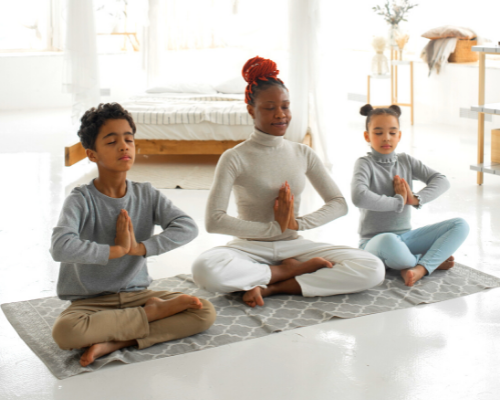Help your kids develop a mindful brain with some exercise.
Are you wondering how to help your child flex their mental-health muscles? The brain is the ultimate mindfulness muscle! Play is the default brain workout for children. Most children effortlessly fall into play that allows them to explore thoughts, express feelings and process the world around them. However, some gentle guidance from parents can help them optimize their brainpower by using some simple elements of “brain fitness.” Specific movements can help keep the brain sharp while providing tools for self-regulation. These exercises are great ways to help your child calm down when upset.
What Is Brain Fitness?
We all understand the importance of physical fitness. Working out and stretching regularly can help us to keep our muscles strong. Movement can also help us stay sharp, avoid injuries and work off pent-up energy. All of those same principles can apply to brain fitness. Brain fitness helps kids build cognitive muscles, avoid mental burnout, and process big feelings in healthy ways by tapping into the mind-body connection. It’s all about movement as meditation.
What Is the Connection Between Physical Activity and Mental Health for Kids?
Exercise is tied to a process called neurogenesis that regulates the creation of new brain cells in different areas of the brain associated with high-order thinking and functioning. Exercise truly makes the brain grow. When a child exercises, synaptic connections between neurons fire off in response to sensory input and environmental stimulation.
Finally, we know that physical activity is linked with a positive mood. When we exercise, the brain releases feel-good chemicals like serotonin and endorphins. In addition, exercise is associated with an improved sense of control, coping abilities and self-esteem. Every parent knows just how important all of those things are for helping a child establish a well-rounded, self-regulating sense of self. A kid can go from feeling down and discouraged to confident and “on top of the world” with just a few minutes of physical activity.
Related Posts:
- Practical Mindfulness Tips for Parenting During COVID
- Adolescent Mental Health Tips
- Reader’s Choice Awards 2021: Health, Lifestyle, & Beauty Winners
What Are Some Ways to Incorporate Brain Exercise Throughout the Day?
There are two ways to incorporate brain fitness into a child’s daily life. The first is to build moments for feel-good exercises into the day. Ideally, a child will take the initiative to integrate exercise into key parts of the day. The second is to give your child essential “emergency exercises” that can be pulled from their emotional toolkits when struggles arise. Take a look at some examples of how brain fitness can fit into a day.
Morning Energizing Exercises
A child can hype up their day by exercising before doing anything else! Teaching a child a few simple yoga moves, Pilates poses or stretches that can be performed right beside their bed after waking up is perfect. This should not necessarily be a grueling or demanding workout. Five minutes spent stretching in silence to trigger an endorphin release for morning energy is all that’s needed.
Intensity Exercises
Is there a particular part of the day when your child has trouble staying focused? Consider exercises requiring extreme focus for the times of day known for “mind wandering.” Look into stretching and flexibility exercises that require countdowns and deep breaths.
Strength Exercises
Incorporating strength-building exercises that require focus and commitment into the busier parts of the day is a great way to encourage a child to burn off any aggression or negative feelings that are bubbling up. Consider pushups, pull-up bars and core exercises for this category.
Firecracker Exercises
Is there a time of day when your child is ramped up with energy? Schedule some high-intensity exercises like jumping jacks, jumping rope or running. Showing your child that it’s perfectly normal to feel restless is so important. It’s even more important to coach them on productive ways to burn off that excess energy.
Calming Exercises
Finally, make sure your child has some “emergency” exercises for calming down in their back pocket for times when they feel out of control. These calming exercises can be breathing or centering exercises instead of “workout” moves. These are ways to calm down that can be done discreetly while a child is in a high-stress situation.
Anthony Cupo is a trained mindfulness facilitator (TMF) from the UCLA Semel Institute for Neuroscience and Human Behavior. He is a co-owner of Stepping Forward Counseling Center, LLC and has been meditating for over 30 years.










Leave a Reply